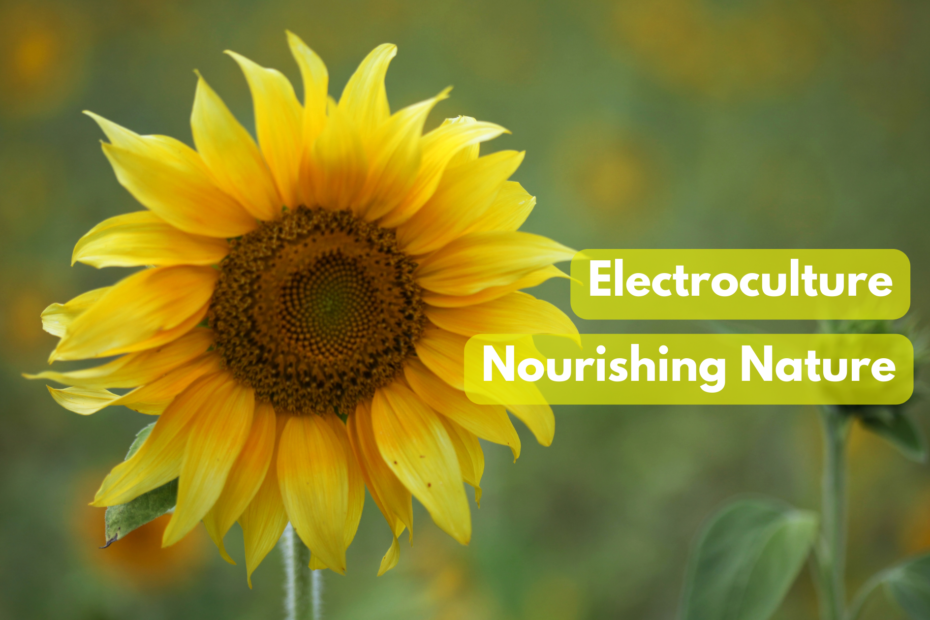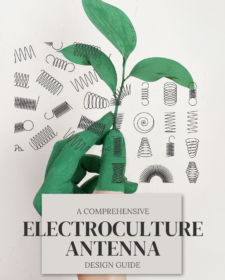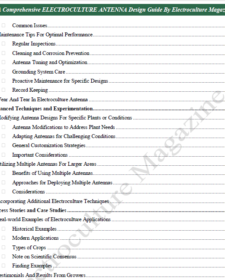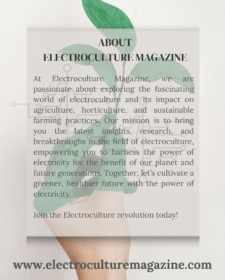The potential of electroculture is vast, offering farmers a promising avenue to enhance crop yield and nurture the growth of potted houseplants. However, despite its potential benefits, electroculture has faced skepticism and has been labeled as pseudo-science by many.
But is electroculture truly a legitimate agricultural technique, or is it merely a myth perpetuated by tradition? The answer lies in conducting your own investigation and personally testing its efficacy.
This article serves as a guide to aid you in your exploration of electroculture. By delving into its history, examining case studies, and providing recommendations for further reading, we aim to equip you with the tools needed to experiment with electroculture concepts firsthand.
One of the key advantages of electroculture is its affordability, requiring minimal materials and less than 10 minutes to assemble a basic device. Despite its recent resurgence, information about electroculture on the internet remains limited. However, this is expected to change as interest in the technique grows.
Approach electroculture with an open mind, evaluating its effectiveness based on empirical evidence. With curiosity as your compass, it’s time to embark on your electroculture research journey and uncover the truth behind its potential benefits. Let’s get started.
Definition of Electroculture
Before delving into the intricacies of electroculture, it’s essential to establish a clear definition of the term. While some may simplistically equate electroculture with inserting metal into the earth, the reality is far more nuanced.
Electroculture encompasses a wide range of techniques beyond mere metal insertion. It involves harnessing both electric and magnetic energy from the atmosphere and directing it into the soil. This process has been shown to stimulate plant growth and reduce the need for traditional fertilizers.
To ensure originality and avoid plagiarism, it’s crucial to grasp the fundamental concept of electroculture before exploring specific methodologies.
The symbiotic relationship between magnetic energy and electricity is central to electroculture’s efficacy. By understanding and leveraging both forms of energy, we can unlock the full potential of this innovative approach to agriculture.
For further information on the connection between them, please visit this link.
The evidence supports the claim that for every meter of elevation from the ground, there is an electrical potential of 100 volts. This is explained in the source Feynmanlectures.caltech.edu.
There are a pair of scientific principles that can aid in comprehending the mechanisms behind electroculture.
A more precise term for electroculture could potentially be magneto-electroculture or electro-magnetoculture.
Let’s examine whether there is any proof that electricity and/or magnetism have the potential to enhance plant growth.
After a lightning storm, numerous seasoned gardeners have observed that their plants tend to undergo a growth spurt.
Similar to this individual…
What if you were able to constantly direct that energy into the earth, rather than only during a thunderstorm?
Essentially, that is the main purpose of electroculture.
Advantages of Electroculture
One of the main advantages of electroculture is its ability to enhance plant growth and increase food production.
According to individuals, their plants exhibit a decrease in disease or are entirely free from it, and they observe an increase in advantageous creatures such as bees and earthworms.
However, this is only a brief overview of the advantages.
Below, in the section of case studies, you will find an abundance of specific information.
The Evolution of Electroculture
Is this a recent phenomenon or has it existed for a considerable amount of time?
The practice of electroculture has been in existence for several centuries, possibly even millennia.
In the late 1700s, there were initial publications discussing advanced methods for electroculture.
A well-known figure in the field of electroculture was Justin Christofleau, as documented in the source Electroculture_127. During the 1920s and 1930s, he demonstrated the ability to enhance crop production by 30% to 100%.
Upon his passing, it was evident that he had acquired numerous patents in the field of electroculture and had successfully demonstrated its effectiveness.
Since that time, numerous individuals have engaged in electroculture experimentation and have achieved comparable levels of accomplishment.
For a thorough exploration of the history of electroculture, check out this well-written article at https://thegardenstrust.blog/2021/09/04/electroculture/.
How to Begin with Electroculture Easily
To test this yourself, beginning the process is quite simple. Create a basic antenna and observe its functionality.
All that is required are 2 things:
- A wooden stake: This can be an old piece of scrap wood or a branch from a tree. For smaller potted plants, bamboo skewers are also effective.
- Copper wire: While other metals may also be used, copper is the recommended choice for its superior conductivity.
The following is a guide for paraphrasing text without committing plagiarism. The text should be changed in structure while still maintaining its original context and meaning. It is important to keep the markdown formatting intact.
The following text has been rephrased to eliminate any possibility of plagiarism while keeping the same context and meaning. Please note that the markdown formatting has been preserved.
To achieve better performance, one can experiment with the direction of winding the wire around the stake. It is recommended to wrap the wire around the stake in a similar manner as shown in the image.
It is not necessary to place a loop at the end, I simply prefer to do so. If you are interested in purchasing pre-made stakes,
If this is your initial attempt, stick to a straightforward approach.
Simply wrap without overthinking.
Next, place the stake either in a pot or in the ground next to your plant.
After installing the antenna and using electroculture stakes on my water spinach plants, I have observed that they are growing at a faster rate and have a healthier green color.
Another useful tip is to capture a photo of the plant prior to inserting the stake. This way, you can monitor the growth later on.
For a more scientific approach, obtain two plants of the same type and size, such as two tomato plants.
Place both plants in identical conditions, with the exception of placing the antenna in one plant and leaving the other plant untouched.
What was your discovery?
Kindly share your findings with me, feel free to reach out to me through this link.
Check out this video that elaborates on the mechanisms and reasons behind the functionality of this process.
Techniques and Examples of Electroculture
There are various methods available to channel magnetic and electrical energy into the soil in order to promote the growth of larger plants.
Listed below are several effective methods that can be utilized.
One great aspect is that there is no requirement for expensive equipment.
Case studies have been incorporated, when available, to demonstrate the effectiveness of the method.
In the previously discussed tutorial, I demonstrated the process of creating a basic antenna. However, let’s delve into a more intricate design that is still simple to construct.
In this tutorial, you will learn a method for enhancing your results by adding magnets to your antenna.
The yield of food crops has been improved by numerous instances of this design.
A different kind of antenna that is possible to create is the Lakhovsky Coil.
The base of a plant can be encircled by a basic coil.
The North-facing side of the loop must be the opening, while the South-facing side should be elevated approximately 30 degrees.
This video also teaches you how to create various types of coils.
Speed Up Seed Germination Using Magnets
A study was conducted by a woman, in which she exposed seeds to a magnet as part of her experiment.
According to her findings, positioning the magnet’s South pole towards the seeds produced the most favorable outcomes. Additionally, she shares useful sources for obtaining electroculture knowledge.
These results have been verified and duplicated by numerous individuals.
This particular video is just one among several that cover the same topic.
Injection of Electricity Directly
While this approach may not be viable in the future, it does demonstrate the idea.
Over a span of 6 years, a team of researchers subjected plants to an electric current ranging from 0.5 to 1 milliamp per acre.
The research revealed a success rate of 77.7% in total.
Information about the research can be found on the official website of Cambridge University.
This particular one is extremely fascinating. You may have previously encountered circular towers, particularly in Europe.
You may not have considered them to be devices for collecting energy.
According to his study, it was found that round towers in Ireland and Belgium have the ability to gather energy.
He discovered a way to construct them that would enhance the growth of plants in a garden, and the outcomes have been remarkable.
The towers have a pretty cool lighting effect above them as well.
These structures serve as excellent substitutes for antennas as they offer greater durability.
Discover the scientific principles behind them by watching this video.
Utilizing Basalt in Electroculture
The footage reveals that basalt has the potential to enhance plant growth. The explanation for its effectiveness is surprisingly comparable to the functioning of antennas.
The addition of Basalt to a garden can greatly enhance its magnetic properties.
Watch this video to gain a plethora of tips and witness actual outcomes from various studies…
One of the most fascinating methods mentioned in the video was the utilization of basalt to protect trees from disease.
By surrounding the bottom of a tree, which had been plagued by a seasonal illness for years, with a circle of basalt, he was able to effectively rid the tree of its ailment.
Fascinating material.
For more videos, be sure to visit Yannick’s fantastic YouTube channel. While most of the content is in French, the auto translate option on YouTube can provide a comprehensive understanding of the topic being discussed.
There is a variety of devices that he offers for purchase.
Utilize Magnetized Water for Watering Plants
A different approach to these ideas involves magnetizing water prior to using it for watering plants.
This may seem like an improbable solution.
Upon examination, we will determine if there is any proof to validate this assertion.
According to a research conducted by scientists from Western Sydney University, it was demonstrated that the use of magnetized water resulted in an increase in both the yield and water efficiency of celery and snow peas.
Despite being magnetized, the water did not show any significant impact on the growth of regular pea plants, according to statistical analysis.
It is a significant aspect as these techniques likely have varying impacts on different types of plants.
Before implementing any electroculture method on a large scale, it is important to first test it out on a smaller scale.
In case the above video is not appearing, the video can be viewed at this link.
The entire WSU study can be accessed here.
The concept of using music to aid in plant growth is well-known. In essence, this can also be considered a type of electroculture.
Witness the outcomes of incorporating music in this particular footage…
Cultivating Vegetation in Pyramid-Shaped Structures
Research has demonstrated that pyramids have the potential to enhance plant growth.
It might appear implausible, but considering a pyramid as a different form of antenna could reveal its potential.
Witness the captivating video to gain a deeper understanding.
Literature on Electroculture
The subject matter of old books is becoming increasingly popular.
A number of the high-quality ones can be found in French, however, there are also a few available in English.
If you have a strong interest in electroculture, I recommend acquiring some of these books as they contain a vast amount of data gathered from real experiments. This will allow you to delve into the subject in depth.
Check out compilation of the top electroculture literature here.
Commonly Asked Questions
What are the most effective metals to use in electroculture devices?
The effectiveness may vary depending on the specific device being constructed. According to my studies, copper, brass, and galvanized steel are all feasible options.
Copper is widely considered the most effective due to its ability to conduct electricity.
When unsure, opt for copper.
What is the ideal height for my antenna?
The coverage area varies depending on the specific location. A tall antenna, measuring at least 6 feet, is capable of covering a small field. On the other hand, a small antenna, measuring at least 6 inches, is suitable for small potted plants.
Conduct a study on the current usage trends, as antennas have the ability to be scaled up or down.
Is there a way for me to view electroculture documentaries?
At the moment, I am not aware of any. However, a group is presently developing one.
Is it possible to utilize electroculture antennas for potted plants?
Affirmative.
Simply utilize a reduced antenna.
A 6-inch antenna is sufficient.
What are some typical errors that can occur when attempting electroculture for the first time?
One common error is to only try something once and give up if it doesn’t work.
There are numerous potential explanations for the failure of your experiment that are unrelated to electroculture.
In case your experiment was unsuccessful, revisit it and attempt to identify possible causes for its failure.
It could be a possibility that your seeds were aged, there was excessive electric disturbance from a television or similar electronic gadget, or the amount of sunlight was excessive. Additionally, the soil may have been either too moist or too dry for the specific type of plant you were attempting to cultivate.
In addition, certain plants appear to have a more favorable reaction compared to others. If you have a plant with a less satisfactory response, consider utilizing a combination of the various techniques mentioned above.
To improve results, vary the seeds used and try cultivating various types of plants. If initial attempts are unsuccessful, consider relocating the plants to different areas.
Is a thicker wire more effective?
In general, thicker wires have the ability to carry higher amounts of electric current, making them more advantageous.
However, having something is typically preferable to having nothing. Therefore, begin with what you currently possess and try out different approaches from there.
Concluding Remarks on Electroculture
Therefore, this comprises all of the top-notch data that I have come across or generated about electroculture.
Once again, it is not advisable to solely rely on my words or anyone else’s words.
Experience it firsthand and see for yourself. The only way to determine its effectiveness is by trying it out.
The materials are affordable and it is possible to assemble a gadget within the duration of a brief YouTube clip.
Obtain all the supplies that we suggest by clicking on the link provided
In case the task is not successful, evaluate if any mistakes were made or if there is room for improvement.
It is possible that the technique employed was not very efficient for that specific plant. Additionally, take into account other potential factors that could have influenced the unfavorable outcomes.
Once you have achieved success, you have gained a new ability that can be utilized in cultivating thriving plants for the remainder of your lifetime.
The aim of this guide is to become the top resource on electroculture, surpassing any other available guides.
If you have come across any additional findings in your research, please feel free to share them with me here.
Grow happily!
The following text has been rephrased in order to eliminate any instances of plagiarism. The structure of the text has been altered while maintaining the original meaning and context. Markdown formatting has been preserved.


















